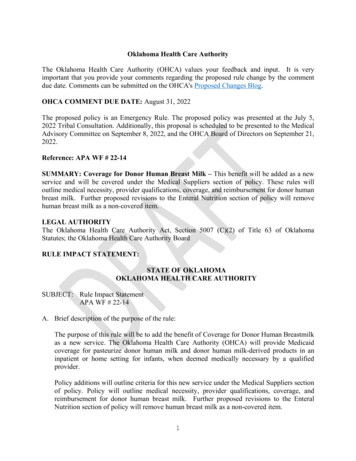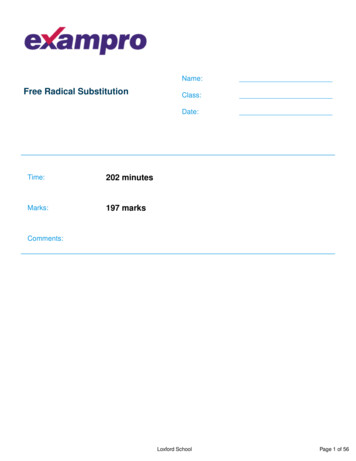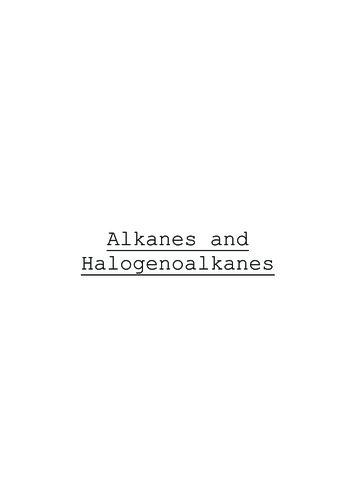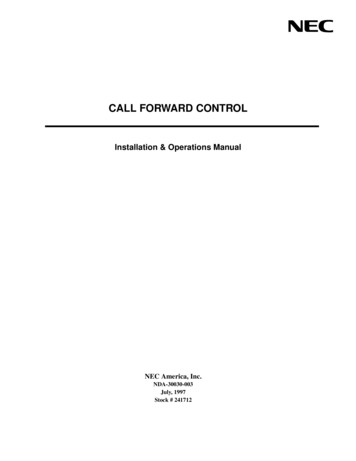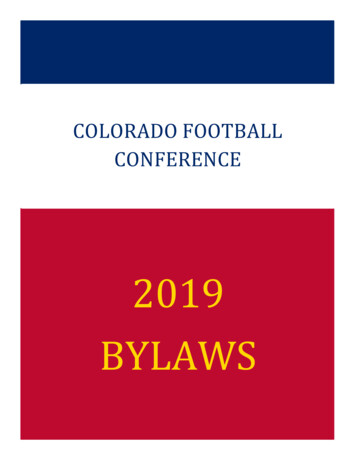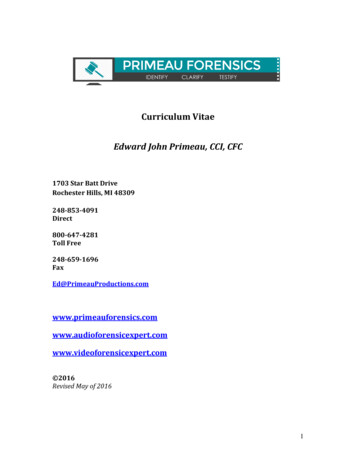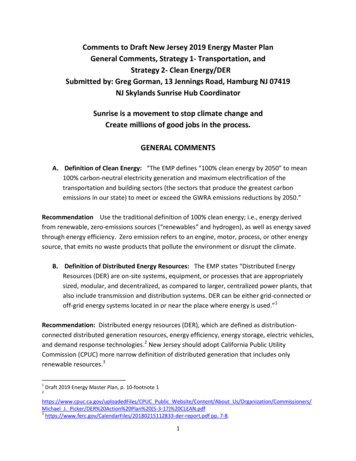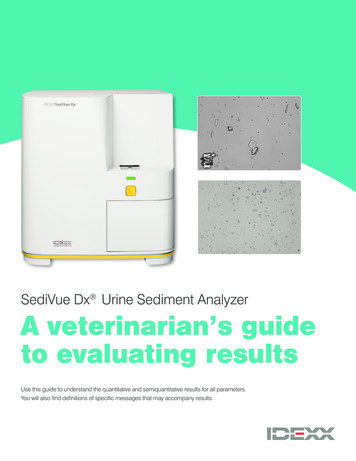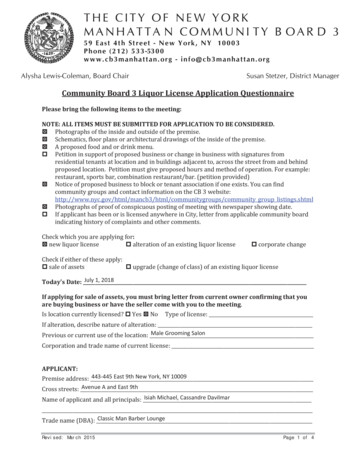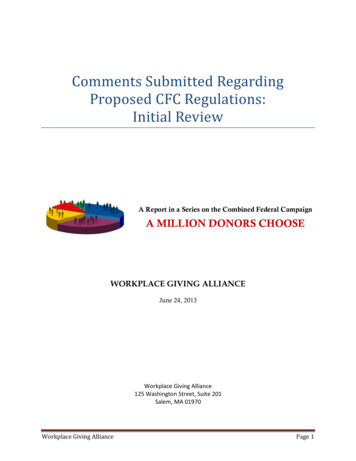
Transcription
Comments Submitted RegardingProposed CFC Regulations:Initial ReviewA Report in a Series on the Combined Federal CampaignA MILLION DONORS CHOOSEWORKPLACE GIVING ALLIANCEJune 24, 2013Workplace Giving Alliance125 Washington Street, Suite 201Salem, MA 01970Workplace Giving AlliancePage 1
Comments Submitted Regarding Proposed CFC Regulations: Initial ReviewThis report was researched and written by the staff of the Workplace Giving Alliance*, whose opinionsare expressed herein.June 24, 2013* The Workplace Giving Alliance is a trade-name for Human & Civil Rights Organizations of America, Inc.The Alliance includes 12 federations that share administrative staff to provide services to over 500 notfor-profit organizations in the Combined Federal Campaign and in state and municipal fundraisingcampaigns.Copyright 2013 Human & Civil Rights Organizations of America, Inc.All Rights Reserved.Workplace Giving Alliance125 Washington Street, Suite 201Salem, MA 01970www.wg-alliance.orgWorkplace Giving AlliancePage 2
Additional Reports in the Million Donors Choose SeriesA Million Donors Choose: Results of the 2009 Combined Federal Campaign – December 2011A Million Donors Choose: Results of the Combined Federal Campaign 2009, 2010, & 2011 – July 2012Federation Fees – January 2013Helping a Million Donors Choose: Online Search in the CFC – May 2013Copies of these reports may be found at www.wg-alliance.org/researchOur Team for this ReportMarshall Strauss – project directorElaine Gerdine – analyst and writerLisa Rosenthal – analyst and writerOther Members of the Workplace Giving Alliance StaffSisi DengCharles DrapalaLeah HamiltonBarbara PuglieseNancy RexfordMember Federations of the Workplace Giving AllianceAnimal Welfare Fund, Inc.Arts Federation, Inc.Child Aid International, Inc.Child Aid USA, Inc.Children and Youth Services, Inc.Health and Human Services Charities of America, Inc.Human & Civil Rights Organizations of America, Inc.Jewish Aid Worldwide: America, Israel and Beyond, Inc.Mental Health and Addiction Network, Inc.Partners for a Better World, Inc.Peace and Reconciliation Charities, Inc. (DBA: Military and Civilians United for Peace)Village by Village, Inc. (DBA: Build a Better World)Workplace Giving AlliancePage 3
June 24, 2013Dear Colleague:In early April, the U.S. Office of Personnel Management published draft regulations for the CombinedFederal Campaign. OPM allowed the public two months to submit comments; many hundreds oforganizations and individuals did so.Though the period allotted for comments ended on June 7, discussion about the future of the CFC hasnot abated. We understand that a subcommittee of the House Committee on Oversight andGovernment Reform will convene a hearing this week to consider the proposed changes to the CFC.Journalists and others continue to follow developments closely.We offer this initial review of the comments submitted to OPM to assist those concerned about thefuture of the CFC. We do not suggest that our work is comprehensive. We have only been able to reviewa relative handful of the submitted comments, but we believe they offer an insight into the issues andconcerns that have been raised. As we are able to read the many other comments that were submitted,we hope to offer updates to this report.Over more than half a century, the CFC has raised billions of dollars in support of thousands of local andnational charities. We support the government’s efforts to improve this program. We hope ourcompilation and review of submitted comments can assist this effort.Sincerely,Marshall StraussCEO, Workplace Giving AllianceSalem MAWorkplace Giving AlliancePage 4
ContentsSection 1: Introduction . 6Source Documents . 8Our Method . 8Section 2: Initial Review of Comments . 101. Changing the Campaign Solicitation Period . 102. Immediate Eligibility. 103. Disaster Relief Program . 114. Local Governance Structure . 115. Electronic Donations . 126. Training and Oversight . 137. Elimination of Paper Processes . 138. Streamlining Campaign Administration . 149. Administrative Costs . 1410. Streamlined Application Process . 1711. Audit of Small Charities . 1712. Oversight of Federations. 1813. Payroll Deduction Disbursements . 18Section 3: Additional Concerns and Recommendations . 19Regarding Process . 19Recommendations Beyond the Regulations . 19Workplace Giving AlliancePage 5
Section 1: IntroductionThis report reflects our analysis of comments which we were able to gather andreview as of June 21, 2013. On June 22, 2013, the government released hundreds ofcomments they had received. We have not yet reviewed these newly publisheddocuments but believe the sample we considered provides a useful initial overview ofthe issues people and organizations have been articulating.On April 8, 2013, OPM released draft regulations that would substantially modify the Combined FederalCampaign. Among many changes, OPM proposed to:Replace the current LFCC-PCFO structure with a new system of Regional CoordinatingCommittees (RCCs) backed up by one or more new Central Campaign Administrators (CCAs)Eliminate the use of the printed directory and pledge card, moving to an on-line pledge systemInstitute an upfront, non-refundable application fee to provide the funds needed to administerthe program around the country.OPM invited reactions from the public, offering more than one path for submitting comments. Thedeadline for such comments was June 7, 2013.Many who wrote used a government website designed specifically to handle such feedback on proposedregulations. Others wrote directly to OPM. Overall, we understand that more than a thousandcomments, from individuals and organizations, were submitted during the time allowed.While individuals generally wrote solely on their own behalf, organizations such as federations oftencommented jointly. In some instances, organizations submitted more than one comment – as part of ajoint statement or letter and then separately.Below is a list of the 35 comments we reviewed for this initial report. We indicate the author andattempt to note when a comment was submitted on behalf of more than one organization. We haveposted all 35 comments on our website so that readers can review the original source material we used.1.American Civil Liberties Union2.American Lung Association3.American Postal Workers Union4.America’s Charities5.Campaign Service Center6.CFC Nexus7.Coastal Carolina CFC8.Colorado Nonprofit Association9.Community Health Charities Member Charities10. Concerned Citizens for Animals11. Emerging Leadership Council for the CFCNCAWorkplace Giving AlliancePage 6
12. Federated Campaign Stewards13. Greater Los Angeles Federal Executive Board14. Hope Stone15. Independent Charities of America and related federations:Animal Charities of America; CancerCure of America; Charities under 1% Overhead, Charities under 5%Overhead; Children’s Charities of America; Children’s Medical & Research Charities of America; ChristianCharities USA; Christian Children’s Charities; Conservation & Preservation Charities of America; Do UntoOthers: America’s Emergency Relief, Development and Humanitarian Outreach Charities; EducateAmerica; Health and Medical Research Charities of America; Hispanic & Latino Charities of the U.S. andthe Americas; Human Care Charities of America; Jewish Charities of America; Local Independent Charitiesof America; Military Family and Veterans Service Organizations of America; Military Support Groups ofAmerica; Sports Charities USA; Wild Animals Worldwide; Women, Children and Family Service Charities ofAmerica16. Independent Sector17. Intermountain CFC18. James P. Huber Veterans Foundation19. Karl Howard20. Patrick Maguire21. Maryland Nonprofits (representing more than 1400 member organizations)22. Vincent Marzullo, Chair, LFCC of Rhode Island and Southeastern Massachusetts23. Medical Research Charities24. Million Dollar Roundtable Advocacy Committee (representing a consortium of 56 large campaigns)25. National Committee for Responsive Philanthropy26. Nonprofit Roundtable of Greater Washington DC (representing 314 nonprofit members)27. Primary Children’s Medical Center Foundation28. Southern California CFC29. Surgeons of Hope30. Ten National Federations and Large Nonprofits:America’s Charities, Christian Service Charities, Community Health Charities of America, EarthShare,Global Impact, Human Service Charities of America, Independent Sector, National Black United Fund,United Way Worldwide, YMCA of the USA31. J. Woodfin Thomas, Chair, Maricopa County LFCC [Arizona]32. United Way of Eastern Upper Peninsula [Michigan]33. United Way of Northern Utah34. United Way Worldwide35. Workplace Giving Alliance:Animal Welfare Fund, Arts Federation, Child Aid International, Child Aid USA, Children and Youth Services,Health and Human Services Charities of America, Human & Civil Rights Organizations of America, JewishAid Worldwide, Mental Health and Addiction Network, Peace and Reconciliation Charities, Village byVillageWorkplace Giving AlliancePage 7
Source DocumentsSome authors refer to the CFC-50 Commission’s recommendations and compare the content of thoserecommendations with that of OPM’s proposed regulations. We provide here a link to that 0-commission/2012-report.pdfSome authors refer to the objectives of the CFC as outlined in executive orders. We provide links below:www.presidency.ucsb.edu/ws/?pid 58865www.presidency.ucsb.edu/ws/?pid 58865Finally, some authors refer to OPM’s stated goal in proposing new regulations, which was “to strengthenthe integrity, streamline the operations and increase the effectiveness of the program to ensure itscontinued growth and success.” We provide a link to the proposed regulations teOur MethodOPM organized the proposed regulations around 13 categories, ranging from changing the campaignsolicitation period to adjusting payroll deduction disbursements. We have used these categories for ourown initial review.Here are the categories, as ordered by OPM in the draft regulations. We place next to each one thenumber of comments that addressed that topic.Categories1. Changing the Campaign Solicitation Period2. Immediate Eligibility3. Disaster Relief ProgramNumber of Comments81474. Local Governance Structure265. Electronic Donations266. Training and Oversight97. Elimination of Paper Processes138. Streamlining Campaign Administration149. Administrative Costs2810. Streamlined Application Process1011. Audit of Small Charities1112. Oversight of Federations813. Payroll Deduction Disbursements8Workplace Giving AlliancePage 8
We note that these categories sometimes overlap. In addition, those submitting comments did notalways organize their own material in parallel to the 13 topics. Still, we found that it helped to sort thecomments by category, and our report offers summaries of what was written about each one.Not all comments dealt with every category. Some who wrote went beyond the OPM categories,seeking to express concerns regarding the process by which the regulations were developed. Othersoffered fresh ideas, not reflected in the draft regulations. Comments tied to the 13 categories arediscussed in Section 2 of this report. Comments that fell outside the 13 categories are addressed inSection 3.We acknowledge that the CFC federations comprising the Workplace Giving Alliance submitted theirown joint comment on June 6, 2013. We have reflected the points we made to OPM in our review buthave sought to give them no greater weight or visibility than the comments offered by others.We emphasize that our review does not attempt to be quantitative or scientific. We have not countedthe number of comments in favor of a regulatory provision or the number opposed. We have not soughtto calculate the degree of support or opposition to a provision, though on occasion we do observe that aprovision has received widespread support or opposition. When we do so, we make a special point ofarticulating the “minority” point of view.Our primary objective is to identify the arguments in favor and in opposition so that those involved inthis effort to update the CFC can be more fully informed. While the comments reviewed for this reportinclude less than 5% of the total number, we believe that they provide a valuable initial snapshot ofreaction to the proposed regulations.Workplace Giving AlliancePage 9
Section 2: Initial Review of CommentsWe turn now to our initial review of the submitted comments, organized by OPM’s13 categories.1. Changing the Campaign Solicitation PeriodOne of OPM’s proposals is to shift the campaign solicitation period, beginning the CFC on October 1 andallowing it to run through January 15.To many, the shift in the campaign solicitation period was non-controversial and was generallysupported without further comment. The most common reason for supporting the shift was:A revised end date of January 15 may increase contribution rates by allowing donors who didnot give before the traditional holiday leave to give after the first of the year.Some who commented expressed concern, citing possible ramifications of the shift:A donor’s payroll allotments might not begin until sometime after the first or second payrollperiod in the new year, thereby diminishing the overall contribution.A shift in the campaign season may adversely affect participation levels or total donations.Some who commented suggested that OPM extend the campaign by one month instead of shifting thecampaign, so that the full campaign season would run from September 1 – January 15. Some of thereasons given are cited below:The CFC -50 Commission recommended extending the campaign end date to January 15, butwas silent on changing the start date.A longer campaign would capitalize on both year-end charitable giving and federal personnelschedules.Some agencies want to start in September.2. Immediate EligibilityUnder current regulations, new federal employees must wait until the next scheduled campaign cycle topledge through the CFC. OPM proposes to provide new employees with information on the CFC at theirorientation and permit them to make pledges within 30 days of being hired, regardless of whether theybegin employment during the CFC solicitation period.Those who supported the proposal argued that it would meet the goal of greater effectiveness andallow employees to immediately give to the charities of their choice upon hire.Some who commented expressed concern about the change’s possible adverse affect on the“efficiency” of the campaign for the following reasons:The proposal lacks detail regarding how out-of-season pledges would be processed.Processing and tracking pledges made by new hires would require constant reconciliationsbetween pledges and payroll deductions.Workplace Giving AlliancePage 10
3. Disaster Relief ProgramThe CFC has historically launched special solicitations when a disaster occurs to which federal employeeswish to respond with financial support. Currently, the OPM Director must authorize each of thesesolicitations individually. OPM now proposes to create a standing mechanism for disaster reliefsolicitations so that they can be launched almost immediately upon news of a disaster.Most of those who commented on the proposed regulations did not address this provision. A handfulexpressed support; two authors did note a lack of detail in the proposal and wished to withhold finaljudgment until it was clear how the program would be implemented.4. Local Governance StructureThe CFC is currently managed on the local level through Local Federal Coordinating Committees (LFCCs)comprised of federal volunteers who select Principal Combined Fund Organizations (PCFOs), reviewapplications, approve campaign expenses, and oversee the PCFO’s CFC functions.OPM proposes to replace the LFCC system with a Regional Coordinating Committee (RCC) structure. In aseparate section of the regulations, Streamlining Campaign Administration (#8 below), OPM alsoexplains that they propose to eliminate PCFOs, allowing the new RCCs to hire firms that would providemarketing support. Back office systems would be centralized and managed separately.RCCs will cover larger campaign regions and, to quote the proposed regulations, be comprised of“Federal inter-agency organizations, such as Federal Executive Boards and Federal ExecutiveAssociations, or personnel assigned to the military installation and/or Federal agency identified as thelead agency in that region.”Among those who opposed this change, much of their argument rested on the benefit of person-toperson contact encouraged by the existing governance structure. Among the points made:OPM is not acting in accordance with Executive Order 12866.Agency heads are more engaged with the CFC when they are given leadership roles; federalworkers want to give more when they see the higher-ups engaged with the campaign;elimination of LFCCs would decrease leadership support on a local level since only one or twoagency heads would potentially serve on an RCC; reduced local leadership will result indecreased donor engagement and participation.The new system will be overwhelmed by applications.Creation of an RCC will increase expenses due to travel, training and additional staff hires.The loaned executive program – a result of the LFCC structure – provides training andexperience to federal workers in management skills, public speaking, and networking.Federal employees currently have a strong sense of ownership and stake in the success of thecampaign, which encourages participation and word-of-mouth marketing for the CFC.The CFC-50 Commission did not recommend this change.There has been no analysis or proposal of how the new regions would be defined orimplemented.Workplace Giving AlliancePage 11
Agency staff and Federal Executive Boards may not want or be able to accept the functions thatwere previously administered by the LFCCs.Some alternative proposals were suggested, including:Leaving the LFCC/PCFO structure in place and finding other ways to audit for waste andinefficiency, such as training retired federal workers to serve as “watchdogs” of some of thelargest CFC campaignsRegionalizing local campaigns in ways that honor the demographics and culture of a particularregion; condensing local zones into larger zones, but not eliminating PCFOs entirelyPiloting the administrative changes before fully implementing them.5. Electronic DonationsOPM proposes to eliminate the use of cash, check and money order donations, shifting the CFC to onlinegifts. The stated goal is to “eliminate burdensome paperwork” and reduce waste.An exclusively electronic donation system would mean elimination of the printed charity booklet infavor of a centralized on-line search tool discussed in Elimination of Paper Processes (#7 below).Additionally, the paper pledge card that donors currently use to select their charities would be replacedby an on-line system.Electronic donation was one of the most widely discussed changes proposed by the new regulations.Some who commented supported the shift to electronic systems, citing the potential to improveefficiency, transparency and accountability for the campaign. Many of the same writers suggested agradual transition to on-line giving, acknowledging it is the “way of the future.”Others who commented opposed the elimination of cash, check and money order donations as well asthe traditional paper methods of pledging. Overall, those writing to express concern suggested that anexclusively on-line system would lead to lower levels of CFC donations, and some cited examples ofdecreased donations in campaigns that had made such a change. Writers argued:Many federal employees do not have convenient or regular access to computers. Someemployees cannot go on-line during the work day for security reasons.Donors, inundated with e-mail fundraising requests, would be more engaged in the CFC if theywere offered a variety of giving options. On-line giving is impersonal; it is easier to delete an email than it is to ignore a paper booklet and pledge card.Many employees attend agency fairs and fundraising events and choose to give using paperpledge cards and cash/checks during these events; these contributions could be lost.The proposal violates the Executive Order for the CFC that says all federal employees will haveaccess to giving.Choice is essential to workplace giving. Donors should be able to give on their own terms, not beforced to give in a certain way. Restricted giving may dissuade donors from giving through theCFC and lead them to give directly to charities.Some donors do not trust on-line systems to protect their personal financial information.Workplace Giving AlliancePage 12
There are up-front costs required for website design, contracts with banks and credit cardcompanies which would occur in the first year.Donors would need to be trained in the use of the e-pledge system.There is added risk in moving all data to a single electronic system; systems can fail or slowdown; hard copies allow for comparison of data in the event of a problem or corruption of data.Suggestions for alternative approaches included:OPM should have electronic applications instead of paper applications to reduce waste.The CFC should find innovative ways to encourage electronic donations without eliminatingtraditional giving methods.The government should at least offer debit card and electronic check options, with both onetime and recurring gift options.6. Training and OversightOPM proposes to offer additional training to the local administrators of the CFC. As stated in theregulation summary: “The training will be conducted by OPM staff and will focus on oversightresponsibilities, charity eligibility requirements, and how to select a marketing organization andreview/approve its reimbursable marketing expenses.”Expanded training received substantial support from those who chose to comment on this element ofthe proposed regulations. Some did express concern, however, that the training would:Add costs to the programReinforce a tendency to move away from the community and toward a more centralized systemRequire OPM staff to handle tasks and material with which they are less familiar.Some of those who expressed reservations about the approach OPM proposed to take on training urgedthe CFC to build on the skills and experience already present at the local level of the program.7. Elimination of Paper ProcessesThe CFC currently provides a printed directory of eligible charities and a paper pledge form. OPM nowproposes to eliminate these tools in favor of on-line resources.Those submitting comments tended to discuss the pledge form in connection with the move toelectronic donations. Readers interested in comments about paper pledge forms are referred toElectronic Donations (#5 above). Comments summarized below pertain to the print directory.We note that no one in our comment sample expressed support for the immediate and completeelimination of the print directory. Here are some of the concerns that we read.A significant portion of the federal workforce – one third or more – does not have access to theInternet on a regular basis. This is particularly true for postal workers. Also, many governmentemployees, particularly in the military, work in secure facilities where Internet access isrestricted.Workplace Giving AlliancePage 13
It is important to have materials to hand out at events.An exclusively on-line system will require a substantially improved search capacity. Absent suchimprovement, donors will be frustrated in their search for charities.8. Streamlining Campaign AdministrationCurrently, most local campaign administration is managed by Principal Combined Fund Organizations(PCFOs). OPM proposes to eliminate PCFOs in an effort to reduce overhead costs and consolidateresponsibilities into one or more centralized back offices – Central Campaign Administrators (CCAs).OPM further proposes that a Regional Coordinating Committee (RCC) as described in Local GovernanceStructure (#4 above) “may engage a marketing firm to continue outreach to Federal, Postal and militarypersonnel, functions currently coordinated by the PCFOs.” Many authors were concerned that thischange would decrease person-to-person contact with potential donors.Many of those who commented on this proposed change expressed support for improvements thatwould increase the efficiency of the campaign, but a number of those who commented argued that theelimination of the current system would undermine the CFC due to a possible loss of institutionalmemory and reduced connection to the local scene. Arguments offered included:PCFOs understand their local communities and can market the campaign in a way that makessense for their local area; an outside marketing firm could be impersonal and have a one-sizefits-all approach to donor outreach.Federal employees are more likely to donate when they have face-to-face contact with akeyworker.Donors may perceive an outside marketing firm negatively because their donations aresupporting highly paid companies that do not have a vested interest in the CFC. The PCFO is anon-profit entity and thus shares a common philanthropic vision with the CFC to minimizeexpenses; a marketing firm would be more likely to want to increase its own profits.Marketing firms would not have the knowledge base to adequately train volunteers.PCFOs have established relationships with non-profit organizations in their local regions.PCFOs currently have access to campaign outreach/marketing as well as historical pledge data;under the new proposal these functions would be split between the CCA and marketing firms,resulting in higher administrative cost and a more complicated procedure for answeringquestions.A concern was also expressed that the requirement that the CCA be a 501(c)3 organization would limitthe potential applicants for the role.9. Administrative CostsOperational expenses for the CFC currently are paid up front by PCFOs and then recovered fromdonated funds when they begin to arrive. OPM proposes to fund operations by charging participatingcharities an application fee. OPM states that the proposed change “shifts the expense of the campaignfrom the donor to the charities” and will bring “more transparency with respect to administrativeoverhead.”Workplace Giving AlliancePage 14
The proposed application fee would be set by the OPM Director each year no later than October 31,based on estimated costs for the year ahead. The fee would be due no later than the applicationdeadline and would not be refundable even if OPM denies the application.This topic received more comments than any other. We, therefore, provide a more substantialdiscussion of the arguments offered. While we generally are not counting the number of pro and conopinions on the proposed regulations, in this case we do feel that it is appropriate to note that thepreponderance of comments opposed OPM’s suggested change.In SupportOne comment, representing numerous national and local federations, did support the introduction of anapplication fee. These federations recommended a flat fee for all applicants, whether national,international or local. They argued that it would be advantageous to distribute 100% of donations tocharities, increasing the likelihood that donors would elect to give through the CFC.The federations supporting this provision argued as well that spreading campaign costs over so manyparticipants would keep the fee low enough that few charities would view it as a major disincentive
Workplace Giving Alliance Page 3 Additional Reports in the Million Donors Choose Series A Million Donors Choose: Results of the 2009 Combined Federal Campaign - December 2011 A Million Donors Choose: Results of the Combined Federal Campaign 2009, 2010, & 2011 - July 2012 Federation Fees - January 2013 Helping a Million Donors Choose: Online Search in the CFC - May 2013
